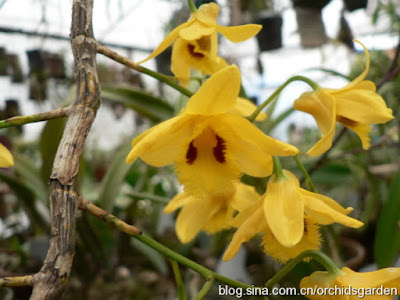Dendrobium hookerianum is native to Central Nepal, north-east India and Yunnan Province of China. In China, these plants grow on volcanic rocks at the west of Tengyuch at an altitude of 1220 m. In the regions of Sikkim and Assam, India, they grow on trees in warm valleys at heights of 1000-2000 m.
Dendrobium hookerianum, also called as Hooker's Dendrobium (named to honor an English Botanist), Callista hookeriana, Dendrobium chrysotis, Dendrobium fimbriatum var. bimaculosum, is a species of the genus Dendrobium. This species was described by John Lindley in 1859.
IDENTIFY DENDROBIUM HOOKERIANUM
Dendrobium hookerianum is native to Central Nepal, north-east India and Yunnan Province of China. In China, these plants grow on volcanic rocks at the west of Tengyuch at an altitude of 1220 m. In the regions of Sikkim and Assam, India, they grow on trees in warm valleys at heights of 1000-2000 m.
It is a small, medium to large sized, cool growing epiphyte or lithophyte, which reaching 100-245 cm in height, with yellowish, pendulous to arching, rod-like canes with basal, 100-245 cm long pseuobulbous swellings that continue to elongate for many seasons and carrying several, dark green, papery, oblong-lanceolate, wavy margined, 18-30 cm long leaves.
Hooker's Dendrobium blooms in the summer and fall on a slender, drooping, 6" (15 cm) long, 9 to 12 flowered inflorescnece with 2 to 4 flowers in groups arising from near the apex of the previous years cane and carrying large fragrant flowers. The gold-yellow flowers are 5-10 cm in diameter. They are the largest flowers among the yellow-flowering Dendrobium. The flakes of both whorls are almost the same. The large, round, velvet lip has a long, shaggy fringe on the edge. It usually has an apricot-yellow color and may have two auburn or dark purple spots.
DENDROBIUM HOOKERIANUM CARE AND CULTURE
Cultural information should only be used as a guide, and should be to be adapted to suit you. Your physical location; where you grow your plants, how much time you have to devote to their care, and many other factors, will need to be taken into account. Only then can you decide on the cultural methods that best suit you and your plants.
Light:
Dendrobium hookerianum needs a light level of 20000-30000 lux and the light should be dispersed.
Temperature:
The average temperature of the summer day is 23 ° C, night 16-17 ° C, giving a daily difference of 7 ° C. In winter, the average day temperature is 15-21 ° C, night 2-7 ° C, giving a daily difference of 13-14 ° C.
Humidity:
From the end of spring to autumn, Hooker's Dendrobium need the humidity of 75-85%, but at the end of winter and at the beginning of spring it drops to 60%.
Substrate, growing media and repotting:
Dendrobium hookerianum is easier to mounted on tree-fern rootstocks or cork. You should then ensure high humidity and watering in summer at least once a day. When it is not possible to cultivate on rootstocks, it is necessary to use hanging pots or baskets filled with any loose, quickly drying media. Repotting can be carried out at any time when the roots are actively growing.
Watering:
Precipitation is very abundant over a 5 summer months, very low for 5 winter months, with short transitional periods in autumn and spring. The plants should be evenly moist from spring to early autumn, but when new growths reach maturity in autumn, the amount of water should be gradually reduced.
Fertilizer:
It is recommended to apply a 1/4-1/2 dose of orchid fertilizer weekly. From spring to mid-summer, it is preferable to use high-nitrogen fertilizer, and then to the end of autumn, high phosphorus fertilizer.
Rest period:
Cold, dry rest period is especially important, and a higher level of light may be necessary to initiate flowering. The plants should survive even temperatures below 0 ° C, if they are dry, but such extreme conditions should be avoided in the cultivation. In winter, Dendrobium hookerianum should dry between waterings, but they can not stay dry for too long. To protect the orchid from drying, it is useful from time to time to spray it in the mornings, especially on warm sunny days. Fertilization should be eliminated until spring, when the amount of water supplied increases.















COMMENTS